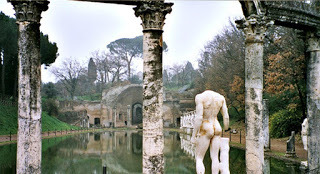Spanish Archaeologists Continue Works to Recover the Elaborate Villa of the Emperor Hadrian
Ancient Origins

In the second century AD, the Roman Emperor Hadrian ordered the construction of a villa for his personal enjoyment as he was not content in his official palace on Palatine Hill. Located on the outskirts of Tivoli, Rome, Hadrian’s villa was actually a small town – complete with palaces, fountains, baths, and a number of buildings that imitated the different architectural styles of the Egyptians and Greeks. Now, a team of Spanish archaeologists has been excavating the site to determine the distribution of the various elements that made up Hadrian’s villa (Villa Adriana in Italian).
According to information published by the Spanish newspaper La Vanguardia , the team is a group of experts consisting of archaeologists, researchers, and students of the University Pablo de Olavide (UPO) in Seville, who have been involved in the excavations of Hadrian’s villa since 2003. With a total of 120 hectares to study, this season of excavations will focus on the area of the Palazzo.
 Imperial palace of the Villa Adriana, Tivoli. (
Public Domain
)"We are in a central area of the villa, in a significant area of the villa, because it is the first residential building constructed by the Emperor Hadrian in the Villa Adriana. The area 'Palazzo' has many problems and it is not yet understood, there are many doubts about many interpretive aspects of this sector of the villa that we intend to solve with our project,” said the director of the project and professor of Archaeology at UPO, Rafael Hidalgo .
Imperial palace of the Villa Adriana, Tivoli. (
Public Domain
)"We are in a central area of the villa, in a significant area of the villa, because it is the first residential building constructed by the Emperor Hadrian in the Villa Adriana. The area 'Palazzo' has many problems and it is not yet understood, there are many doubts about many interpretive aspects of this sector of the villa that we intend to solve with our project,” said the director of the project and professor of Archaeology at UPO, Rafael Hidalgo .The Mighty Wall of Hadrian, Emperor of Rome Archaeologists discover hidden slave tunnel beneath Hadrian’s Villa Throughout the 13 years of fieldwork, they have found that there were originally three courtyards with wooden floors, marble walls of different colors in the imperial residence and, although most of the decoration was plundered, there are still some remnants which clearly show Hadrian’s passion for ostentation and luxury.
"Playing with pieces of marble that we finding in excavations, we can reconstruct what all this was before it was sacked. We know that these spaces were decorated with marble, both the floor and the walls," Rafael Hidalgo told La Vanguardia.
 Black and white mosaic pavement; on the background wall: traces of frescoes and of opus reticulatum. From the Hospitalia at the Villa Adriana in Tivoli. (
Public Domain
)To date, one of the most important discoveries that the Spanish experts have brought to light in the area of the "Palazzo", has been the oldest known Roman 'stibadium' (banquet hall) - a room that became fashionable during the Roman empire, although its origin is much older.
Black and white mosaic pavement; on the background wall: traces of frescoes and of opus reticulatum. From the Hospitalia at the Villa Adriana in Tivoli. (
Public Domain
)To date, one of the most important discoveries that the Spanish experts have brought to light in the area of the "Palazzo", has been the oldest known Roman 'stibadium' (banquet hall) - a room that became fashionable during the Roman empire, although its origin is much older. They were also able to confirm that there were a number of indoor rooms in the residential palace, exclusively for the use of the emperor, that open onto a central courtyard. There was a great fountain with two individual latrines on the sides as well.
Ancient tablet dedicated to Emperor Hadrian may explain mystery of Jewish revolt Marcus Aurelius: Life of the Famous Roman Emperor and Philosopher “The individual latrine is a very important feature of the Villa Adriana because the use of latrines in the Roman world did not have the same concept of privacy that we have today, so it is very unusual that a Roman building has a latrine with a single seat” Hidalgo explained to La Vanguardia.
Finally, the palace was also found to have housed, as expected, a "garden terrace", which in turn flowed into a large porch.
 The UPO team during excavation work in the 'stibadium.’ (www.upo.es) Featured Image: Canopus of Hadrian’s Villa. (
Public Domain
)
The UPO team during excavation work in the 'stibadium.’ (www.upo.es) Featured Image: Canopus of Hadrian’s Villa. (
Public Domain
)By Mariló T. A.
This article was first published in Spanish at http://www.ancient-origins.es and has been translated with permission.
Published on April 24, 2016 03:00
No comments have been added yet.



